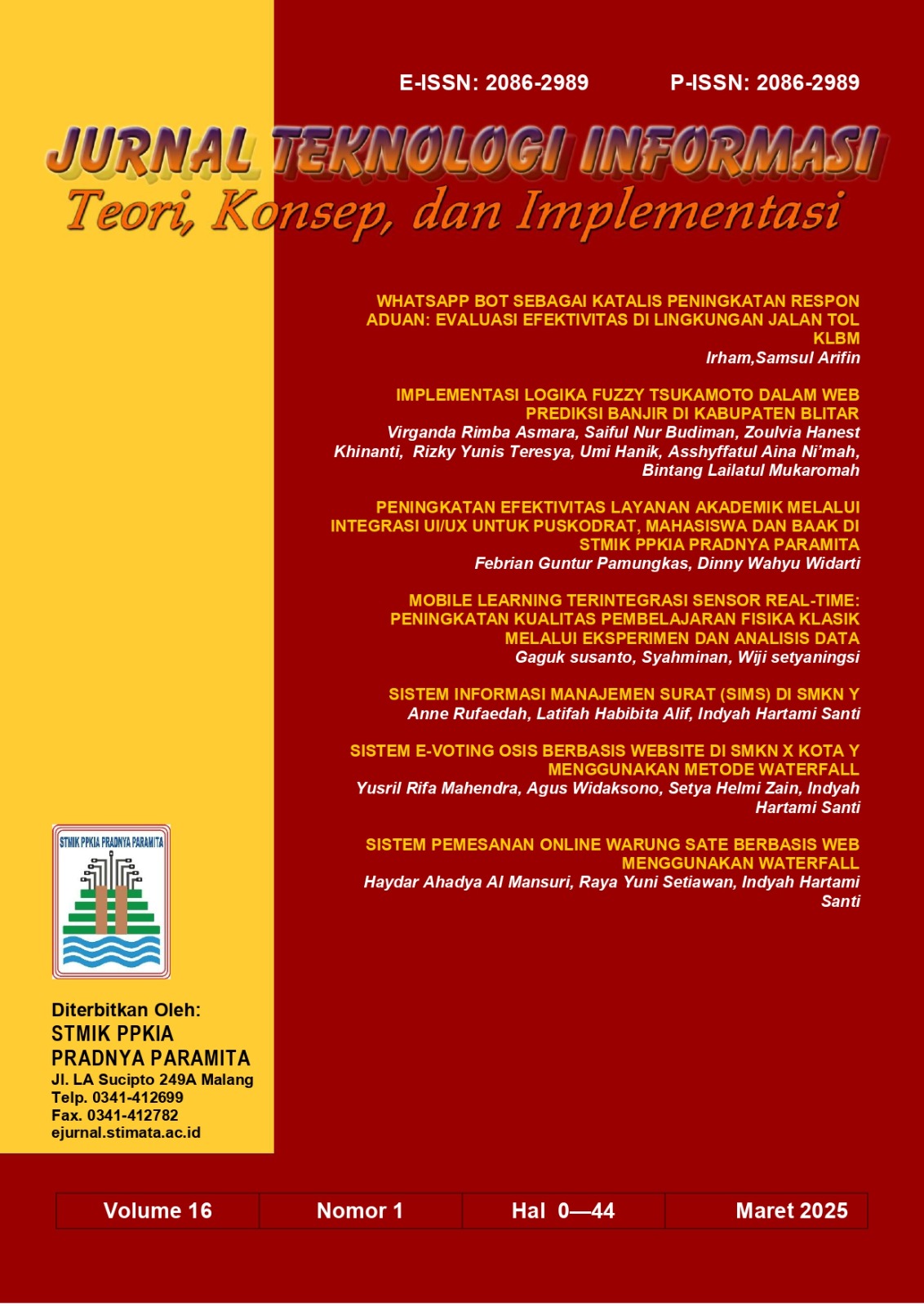Mobile Learning Terintegrasi Sensor Real-Time: Peningkatan Kualitas Pembelajaran Fisika Klasik melalui Eksperimen dan Analisis Data
DOI:
https://doi.org/10.36382/jti-tki.v16i1.561Keywords:
eywords: Physics Learning, Android Application, Educational Innovation, Interactive Media, Newton's LawsAbstract
Abstract
The use of mobile technology in education has developed rapidly, especially through Android-based applications. This study aims to examine the effectiveness of an interactive Android application in enhancing students’ understanding of physics concepts in senior high school. The research employed a quasi-experimental method with a pretest-posttest control group design. The subjects were 60 eleventh-grade science students from a senior high school in Malang Regency, divided into an experimental group and a control group, each consisting of 30 students. The experimental group used an Android application developed for learning Newton's Laws, while the control group used conventional methods. The results showed a significant improvement in conceptual understanding in the experimental group compared to the control group. These findings indicate that Android applications can serve as effective and engaging learning media for students.
K
References
1. [2] Y. Zou, J. Zhao, Y Sardiman. (2010). Interaksi dan motivasi belajar mengajar. Jakarta: Rajawali Pers.
2. Huda, M. (2013). Model-model pengajaran dan pembelajaran. Yogyakarta: Pustaka Pelajar.
3. Herayanti, L., & Habibi. (2015). Model pembelajaran berbasis masalah berbantuan simulasi
4. komputer untuk meningkatkan keterampilan berpikir kritis calon guru fisika. Jurnal
5. Pendidikan Fisika dan Teknologi, 1(1), 61-66
6. Gunawan, Harjono, A., & Sutrio. (2015). Multimedia interaktif dalam pembelajaran konsep listrik bagi calon guru. Jurnal Pendidikan Fisika dan Teknologi, 1(1), 9-14.
7. Husein, S., Herayanti, L., & Gunawan. (2015).Pengaruh penggunaan multimedia interaktif
8. terhadap penguasaan konsep dan keterampilan berpikir kritis siswa pada materi suhu dan kalor. Jurnal PendidikanFisika dan Teknologi, 1(3), 221-225.
9. Lesmono, A. D., Wahyuni, S., & Fitriya, S. (2012).Pengembangan petunjuk praktikum fisika
10. brbasis laboratorium virtual (virtual laboratory) pada pembelajaran fisika di SMP/MTs. Jurnal Pembelajaran Fisika, 1(3),272-277.
11. Huda, M. (2013). Model-model pengajaran dan pembelajaran. Yogyakarta: Pustaka Pelajar
12. Widiyanto, J. (2011). Penggunaan media berbasis komputer untuk meningkatkan prestasi
13. belajar mahasiswa. Jurnal Pendidikan MIPA,3(1), 42-46.
14. Salam, H., Setiawan, A., & Hamidah, I. (2010). Pembelajaran berbasis virtual laboratory untuk meningkatkan penguasaan konsep pada materi listrik dinamis. Proceedings of
15. The 4th International Conference on Teacher Education (pp. 688-692). Bandung: UPI.
16. Lesmono, A. D., Wahyuni, S., & Fitriya, S. (2012).Pengembangan petunjuk praktikum fisika
17. brbasis laboratorium virtual (virtual laboratory) pada pembelajaran fisika di SMP/MTs. Jurnal Pembelajaran Fisika, 1(3),272-277.
Agustine, D., Wiyono, K., & Muslim, M. (2014).Pengembangan e-learning berbantuan irtuallaboratory untuk mata. Wu, and B. Wang, “Segmenting star images with complex backgrounds based on correlation between objects and 1D Gaussian morphology,†Appl. Sci., vol. 11, no. 9, pp. 1–12, 2021, doi: 10.3390/app11093763.
[3] K. Anwar, M. Yunus, and Sujito, “Segmentasi Citra Warna Otomatis Rambu Lalu Lintas dengan Penerapan Mask Thresholder,†J. Edukasi dan Penelit. Inform., vol. 7, no. 3, pp. 481–487, 2021, doi: 10.26418/jp.v7i3.49969.
[4] S. Arumugadevi, “Color Image Segmentation Using Feedforward Neural Networks with FCM,†vol. 13, no. October, pp. 491–500, 2016, doi: 10.1007/s11633-016-0975-5





